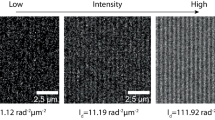Abstract
As is well known, the light scattered transversely when traversing a column of gas or vapour is not completely polarised, the defect of polarisation depending on the nature of the substance. The explanation of this phenomenon as developed by the late Lord Rayleigh, Born, Sir J. J. Thomson and others is that the molecules which scatter the light are optically anisotropic, that is, have different refractivities in different directions, and are oriented arbitrarily in space. From the point of view of dispersion-theory, the interpretation usually given is that the electrons responsible for the refraction of light are anisotropically bound in the molecule.
This is a preview of subscription content, access via your institution
Access options
Subscribe to this journal
Receive 51 print issues and online access
$199.00 per year
only $3.90 per issue
Buy this article
- Purchase on Springer Link
- Instant access to full article PDF
Prices may be subject to local taxes which are calculated during checkout
Similar content being viewed by others
Author information
Authors and Affiliations
Rights and permissions
About this article
Cite this article
RAMAN, C. The Structure of Molecules in relation to their Optical Anisotropy. Nature 114, 49–50 (1924). https://doi.org/10.1038/114049c0
Issue Date:
DOI: https://doi.org/10.1038/114049c0
Comments
By submitting a comment you agree to abide by our Terms and Community Guidelines. If you find something abusive or that does not comply with our terms or guidelines please flag it as inappropriate.



